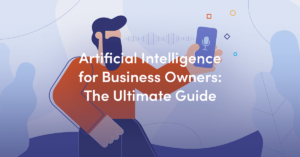Why introduce AI in your company?

Imagine if you could transform your small or medium-sized business into an efficient, innovative force that not only survives but excels in today’s digital battlefield. How about I tell you that artificial intelligence (AI) can be your unspoken ace in the hole? And one that helps you to plant your brand in the hearts of your target group – firmly and with consistency.
Introducing AI into a company may sound like a task reserved exclusively for the big players. But here’s a secret: the technology is more mature and accessible than ever before. From personalizing customer communication to automating time-consuming tasks, AI offers a range of opportunities to drive your business forward.
Introducing AI in the company Step 1: Understanding the importance of AI for company growth
Let’s start with the basics. Artificial intelligence – for some, this still sounds like science fiction or the Fraunhofer IAO research laboratory. But AI is already a practical component of effective corporate strategies today. From production to management to customer service: using artificial intelligence means taking a huge leap towards future viability.
When thinking about how AI can revolutionize work in your company, it’s important to identify which processes can be improved through automation and intelligent analysis. It’s not about replacing people, but about supporting employees through the use of AI and enabling them to focus on the aspects of their work that require human creativity and guidance.
A blog or a contact portal equipped with AI applications can, for example, help to process customer inquiries more efficiently. This ensures that your customers’ concerns go directly to the right contact person. The introduction of artificial intelligence can also be used to gain useful insights from large volumes of data, which are essential for strategic decisions in the company.
Summary: The aim should always be not only to use new technical solutions, but also to create concrete benefits through their use – whether it’s speeding up production, improving customer engagement or optimizing marketing. AI can make a decisive contribution here by providing data-driven insights that were previously inaccessible.
Introducing AI in the company Step 2: Analyze your own business processes for optimization potential through AI
When it comes to introducing AI in your company, it all starts with an in-depth analysis of your business processes. Before you usher in a new digital age, you should understand where and how artificial intelligence can make your work and that of your employees easier.
An in-depth examination and consultation of the activities currently carried out in your company will provide information on where the use of AI could have a positive impact. Whether it is production, which could benefit from intelligent automation, or management and data evaluation, which could be revolutionized by predictive analytics, it is important to identify those areas where AI can make a significant difference.
Your company’s blog can be a starting point – use AI-powered SEO analytics to optimize your content for your target audience. Or consider customer service – chatbots with artificial intelligence could be the first port of call, giving employees more time for more complex consultations. Other softwares like Multimodal AI can take this a step further by understanding text, speech, and images at once, making it easier to handle complex customer service tasks. Recognizing employees who adapt quickly to these AI-driven tools can encourage wider adoption, and employee recognition software helps track and celebrate these contributions, fostering a culture of innovation.
The introduction of AI should also be considered from the perspective of data optimization. AI systems are able to extract important insights from a wealth of data and thus not only improve processes in the company, but also identify new business opportunities.
Ultimately, a structured step-by-step approach forms the foundation for the successful integration of artificial intelligence. To fully leverage these technologies, having the right infrastructure in place is essential, and computer inventory software ensures seamless management of hardware resources. Set clear goals and use existing digital touchpoints to effectively experience the benefits of AI for your company and employees.
Summary The introduction of AI in a company begins with a detailed examination of existing workflows. Together with your employees, you should uncover where AI can increase efficiency and optimization. From production to customer service – there are opportunities for AI to create added value everywhere. Get advice from AI experts and consult industry studies. Investing in AI is a crucial step that will future-proof your company and usher in a new era of digital growth.
Introducing AI in the company Step 3: Identify suitable areas of application for AI in the company

After analyzing the business processes, the next step is the heart of the digital transformation: identifying suitable areas of application for AI in the company. This calls for strategic thinking based on a clear understanding and advisory support.
Start by taking a look at the data that your company collects and generates. Artificial intelligence has the potential to generate new insights and automated recommendations for action from this data. For example, you can revolutionize customer management by creating personalized offers and increasing customer satisfaction.
A digitalization push could also be useful in the area of production, where AI-controlled machines and process optimization can contribute to efficiency and cost reduction. Cooperation with institutes such as the Fraunhofer IAO, which offer practical solutions and sound advice, provides support here.
In order to identify specific areas of application, you should obtain feedback from employees. They are the ones who do the day-to-day work and know exactly where digital assistance and artificial intelligence would bring the greatest benefit. A new contact or customer service bot that processes FAQs independently could be an example here.
Of course, in this day and age, an online presence is a must. An intelligent blog management or content creation system such as neuroflash can help to reach new customers and increase company sales by optimizing SEO and personalized content.
Possible areas of application for AI in the company:
- Customer management: personalized customer experiences and effective advice
- Production: process optimization and automation
- Inventory and supply chain management: forecasting and rationalization of stocks
- Human Resources: Automated applicant screening and employee development
- Marketing: Data-driven decisions and content creation
- IT security: anomaly detection and preventive measures
- Corporate strategy: market analyses and competitive research
Summary Identifying areas of application for AI in the company is a crucial step in making the most of the benefits of digital adoption. From the data-driven optimization of production to the automation of customer management – AI offers a wide range of opportunities to improve processes and make employees’ work easier. By involving consulting institutes and using specialized tools such as neuroflash, you can ensure that your company benefits from artificial intelligence innovations in the right areas.
Introducing AI in the company Step 4: Selecting the right technologies and tools for implementing AI
Once the potential fields of application for artificial intelligence in the company have been identified, the next step is to select the appropriate AI technologies and tools. This process is essential, as the right choice can mean the difference between a successful digital transformation and a project that fails to deliver the desired results.
Before you dive into the world of artificial intelligence, consult with experts and do thorough research. Also analyze your existing data and information flows; you need to understand which technologies are compatible with your company’s data structures.
Individual processes play a role in every step of the digital introduction of AI in the company. Whether it’s improving production, personalizing marketing or managing customer contacts more efficiently, the AI tools you choose should be tailored to your business. Prioritize solutions that enable seamless collaboration with employees and at the same time open up new, innovative ways of working.
It is also important that AI tools and technologies comply with current security standards, particularly with regard to compliance with the General Data Protection Regulation. Your customers and employees must be able to rely on their data being secure.
Possible AI technologies for implementation in the company:
- Machine learning platforms for prognostic analyses
- Natural Language Processing (NLP) tools for improved customer interactions
- AI-supported CRM systems for personalized customer relationship management
- Automation software for repetitive tasks in accounting and administration
- Predictive maintenance tools for production facilities
- Chatbots for initial contact in support or at other customer contact points
- Content management systems that generate SEO-optimized blogs and website content
Summary Choosing the right AI technologies and tools is a critical step on the path to digital transformation. The aim is to find tools that harmonize with the company’s data and processes, offer employees added value and meet current and future security requirements. By collaborating with institutions such as the Fraunhofer IAO and using AI tools such as predictive maintenance systems, NLP applications and intelligent content management systems, you will lay the foundations for the future-proof and successful use of AI in the company.
Learn more about
AI chatbots
or
AI in text creation
.
Introducing AI in the company Step 5: Establish a competent internal or external expert group for the implementation of AI projects
The introduction of AI in a company is not a sprint, but a marathon. In order to successfully complete this marathon, it is essential to build up a group of experts – whether internally or by bringing in external specialists. This group of experts will be the driving force behind the implementation of your AI projects.
Creating an internal AI expert group means empowering existing employees through training and practical advice so that they can meet the new digital challenges. This not only strengthens knowledge within your company, but also promotes awareness and acceptance of AI.
External advice can also be of great benefit. Establish contact with specialists or consulting firms that specialize in the digital introduction of artificial intelligence. Organizations such as the Fraunhofer IAO can provide you with groundbreaking insights and support for your AI processes. They can help to open up new perspectives and pave the way for artificial intelligence in the company.
When implementing AI projects, it is also important to involve management. AI must not be just “another IT project” – it must become a central pillar of the corporate strategy. In this way, you ensure that the introduction of AI is not just a step, but a significant leap for your company.
Summary The successful use of AI in a company depends crucially on the people who understand and use this technology. By creating internal AI know-how and bringing in external expertise, you not only ensure the success of your AI projects, but also firmly integrate the new intelligence into the structures of your company.
Introducing AI in the company Step 6: Integrating data protection and data security into the use of AI technologies

With the introduction of AI in the company comes the essential responsibility to seriously address the issues of data protection and data security. The use of AI must integrate the principles of data minimization and data protection from the outset, as artificial intelligence often works with sensitive data.
When digitally integrating AI technologies, compliance with applicable laws, such as the GDPR in the EU, is mandatory. Close cooperation with management, the IT department and, if necessary, external consultants ensures that data protection and data security can be guaranteed. Experts, including those from institutes such as the Fraunhofer IAO, can provide advice on the implementation of AI technologies.
Effective AI requires high-quality data. Your company and its employees should ensure that only the data that is actually needed is used (data minimization) and that contact with the user remains transparent. When new data is generated as part of AI processes, it is important to obtain the consent of the data subjects clearly and unambiguously.
Finally, the technical and organizational protection of data is another critical point. Regular security audits and training are just as much a part of a prudent AI strategy as a well thought-out authorization concept and continuous improvements to the security system.
Summary The integration of data protection and data security is not an afterthought when introducing AI in a company, but the core of a trustworthy and legal implementation. It is not just about establishing new processes, but also about taking into account the rights and expectations of users and customers. Competent data protection management forms the unshakeable foundation for the successful use of AI technologies in the digital age.
Introducing AI in the company Step 7: Test phase and continuous improvement of the implemented solutions
Implementing AI in the company is just the beginning. The true value unfolds through the continuous monitoring and improvement of AI-supported processes. An extensive testing phase is invaluable to ensure the functionality and efficiency of your new AI applications.
It is important to create an environment in which employees, supported by professional advice, can provide feedback on working with AI-supported tools. The comparison of expectations and actual results provides information on where adjustments are necessary. During this test phase, you should not hesitate to seek external feedback, for example from the Fraunhofer IAO or other experts in the field of artificial intelligence.
The continuous improvement of AI solutions is based on data, feedback and performance measurements. It is therefore essential that all relevant data is included in the analysis and presented in an understandable way. Regular contact with providers of AI solutions can also be helpful to ensure that your company benefits from the latest developments.
Summary A thorough test phase is essential for the successful introduction of AI in a company. It offers the opportunity to identify weaknesses and adapt the applications to the specific needs of your company. Strong management of AI projects and continuous improvement through the collection and analysis of data are crucial to derive maximum benefit from AI processes.
Introducing AI in your company Step 9: Don't wait any longer and take the next big step for your company - with neuroflash

Are you ready to welcome the digital revolution into your company and put the power of AI to work for you? With neuroflash, you can not only simplify the process, but also speed it up. Our advanced AI content suite is specifically designed to help you communicate efficiently and relevantly – whether for blogs, social media or SEO-optimized copy.
Benefit from customized content production that reflects your brand and say goodbye to monotonous content creation processes. Our tool supports you every step of the way – from brainstorming to analyzing the performance of your texts. And the best part? You can achieve all this while saving time and allowing your employees to focus on their core competencies.
At neuroflash we take data security seriously and our platform is fully GDPR compliant. Rely on a solution that offers the best German AI-based content and join our network of over one million users.


















